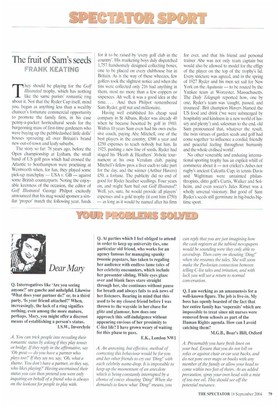The fruit of Sam's seeds
FRANK KEATING
They should be playing for the Golf Illustrated trophy, which has nothing like the same purists' romantic ring about it. Not that the Ryder Cup itself, mind you, began as anything less than a wealthy chancer's fortunate commercial opportunity to promote the family firm, in his case penny-a-packet horticultural seeds for the burgeoning mass of first-time gardeners who were buying up the pebbledashed little dolls' houses sprouting all over Britain's brand new out-of-town and lea' suburbs.
The story so far: 78 years ago, before the Open championship at Lytham, the small band of US golf pros which had crossed the Atlantic to Southampton were practising at Wentworth when, for fun, they played some pick-up matchplay — USA v. GB — against some British counterparts. Noting the enjoyable keenness of the occasion, the editor of Golf Illustrated George Philpot excitedly announced that his mag would sponsor a similar 'proper' match the following year, funds for it to be raised by 'every golf club in the country'. His marketing boys duly dispatched 1,757 handsomely designed collecting boxes, one to be placed on every clubhouse bar in Britain. As is the way of these wheezes, few golfers took the slightest notice and when the tins were collected only 216 had anything in them, most no more than a few coppers or sixpences. Ah well, it was a good idea at the time.. .. And then Philpot remembered Sam Ryder, golf nut and millionaire.
Having well established his cheap seed company in St Albans, Ryder was already 40 when he became besotted by golf in 1910. Within 10 years Sam even had his own exclusive coach, paying Abe Mitchell, one of the best players in the country, £500 a year and £250 expenses to teach nobody but him. In 1923, pushing a new line of seeds. Ryder had staged his 'Heath & Heathers' 36-hole tournament at his own Verulam club, paying Mitchell's fellow pros a fiver each to take part for the day, and the winner (Arthur Havers) £50, a fortune. The publicity did no end of good for Ryder heather seedlings. Four years on, and might Sam bail out Golf Illustrated? Well, yes, sure, he would provide all players' expenses and a gold trophy (it cost him £750) — as long as it would be named after his firm
for ever, and that his friend and personal trainer Abe was not only team captain but would also be allowed to model for the effigy of the player on the top of the trophy's lid. Every stricture was agreed, and in the spring of 1927 Ryder and his men set sail for New York on the Aquitania — to be routed by the Yankee team at Worcester, Massachusetts. The Daily Telegraph reported how, one by one, Ryder's team was 'caught, passed, and trounced'. Brit champion Havers blamed the US food and drink (we were submerged by hospitality and kindness in a new world of luxury and plenty') and, salesman to the end, old Sam pronounced that, whatever the result, the twin virtues of garden seeds and golf had come together 'to influence a cordial, friendly and peaceful feeling throughout humanity and the whole civilised world'.
No other venerable and enduring international sporting trophy has an explicit whiff of commerce about it — not cricket's Ashes nor rugby's ancient Calcutta Cup; in tennis Davis and Wightman were untainted philanthropists, ditto golfs Curtis, Walker and Solheim, and even soccer's Jules Rimet was a wholly unvenal visionary. But good ol' Sam Ryder's seeds still germinate in big-bucks bigtime sport.


















































































 Previous page
Previous page